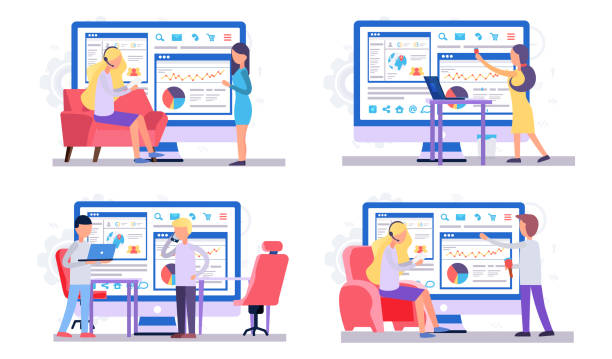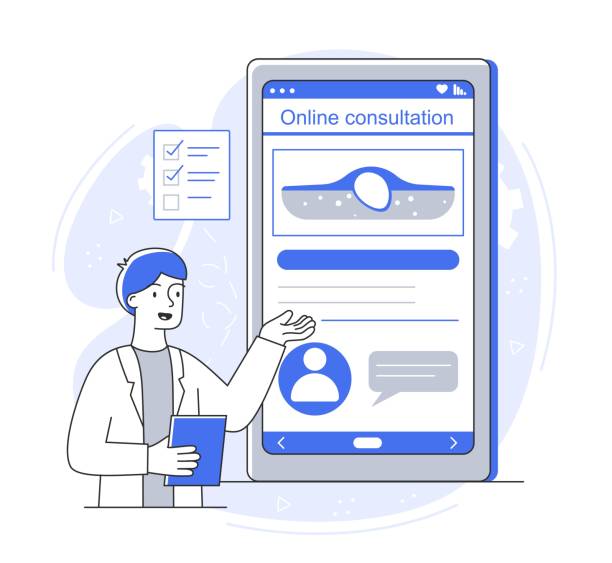Introduction to Responsive Website Design: The Necessity of the Digital Age
![]()
In today’s world, where users connect to the internet through various devices including smartphones, tablets, laptops, and desktop computers, the importance of #website_design and #responsive_website_design has become more apparent than ever.
It is no longer possible to expect a single, static version of a website to provide an optimal user experience across all these devices.
Responsive Web Design is the answer to this challenge.
This approach means designing and developing a website that can automatically adapt its layout and content to the screen size and orientation of the user’s device.
This flexibility ensures that users, regardless of the device they use, have the best visual and operational experience.
In the past, many businesses created separate versions for mobile and desktop, but this method was costly and difficult to maintain.
Responsive design, using techniques such as Media Queries in CSS, fluid grids, and flexible images, has solved this problem and provides a unified and efficient solution.
This not only reduces costs but also significantly helps improve SEO and website ranking in search engines, as Google prefers responsive websites over separate mobile websites.
In this specialized and educational article, we will examine all aspects of responsive website design so that you can design a website suitable for the needs of today’s and tomorrow’s web.
Did you know a weak corporate website loses you many opportunities daily? Solve this problem forever with professional corporate website design by Rasavab!
✅ Create a powerful and reliable image for your brand
✅ Attract new customers effectively and increase sales
⚡ [Get Free Website Design Consultation]
Basic Principles and Techniques of Responsive Design

To deeply understand responsive website design, it is essential to familiarize ourselves with its underlying principles and techniques.
The three main pillars of this approach include Fluid Grids, Flexible Images, and CSS Media Queries.
Fluid Grids mean that instead of using fixed pixel units for dimensions and spacing, relative units like percentages are used.
This ensures that the website layout scales smoothly rather than breaking at different screen sizes, and content is arranged correctly.
Flexible Images work similarly to grids; by using properties like `max-width: 100%` in CSS, images ensure that they never overflow their parent container and scale up or down to fit the available space.
However, the most important tool in adaptive design is Media Queries.
Media Queries allow web designers to apply specific CSS rules based on device characteristics such as screen width, height, orientation, and even resolution.
For instance, you can define that on screens narrower than 768 pixels, the navigation menu should display vertically instead of horizontally, or font sizes should be reduced.
This capability gives the designer unparalleled control over how content is displayed on different devices.
Furthermore, the concept of “Mobile-First” is a key principle in responsive website design.
This approach recommends starting the website design for the smallest screen (mobile) first, and then progressively enhancing it for larger screens (tablet and desktop).
This ensures that you initially focus on essential content and core functionality, and then add visual enhancements and details for larger devices.
This method guarantees optimized loading and performance on mobile devices, which often have lower bandwidth, and prevents loading unnecessary CSS code.
This specialized and educational approach is the foundation of any modern and user-friendly website.
Advantages of Responsive Design for Users and Businesses

Using responsive website design is not merely a design trend, but a strategic necessity for any online business.
From a user’s perspective, a responsive website provides a seamless and optimized experience regardless of the device type.
This means there’s no longer a need for annoying zooming or horizontal scrolling to view content; buttons and links are easily clickable, and forms are simple to fill out.
This improvement in user experience (UX) directly impacts customer satisfaction and, consequently, increases conversion rates and user retention on the site.
From a business perspective, responsive website design offers numerous advantages.
Firstly, SEO optimization is one of the most important.
Google has explicitly stated that it prefers responsive websites over separate mobile websites, as a single URL for content makes indexing and crawling easier for search engines.
This helps improve your website’s ranking in search results.
Secondly, reduced development and maintenance costs are another significant benefit.
Instead of developing and maintaining two or more separate websites for different devices, only one website with a single codebase is managed, which dramatically reduces the costs and time required for updates and bug fixes.
Thirdly, increased access to a wider audience; given the growing use of mobile devices for internet access, having a responsive website allows you to provide services to all your users, regardless of their device, ensuring no potential customer is lost.
This analysis indicates that investing in responsive website design is a smart decision with a high return on investment.
Comparison of Web Design Approaches
| Feature | Responsive Design | Adaptive Design | Separate Mobile Version (m.website.com) |
|---|---|---|---|
| Number of Site Versions | One version | Several predefined versions | Two or more versions |
| Flexibility | High (more complexity in initial coding) | Medium (only for specific breakpoints) | Low (requires separate management) |
| SEO Management | Very Easy (one URL) | Medium (requires redirect settings) | Difficult (requires Canonical and Redirect) |
| Maintenance Cost | Low | Medium | High |
| Best Use Case | Most modern websites | Websites requiring precise content control based on device | Older or very complex websites |
Tools and Frameworks for Developing Responsive Websites

To facilitate the responsive website design process, developers have turned to a set of tools and frameworks that accelerate and standardize the work.
One of the most well-known and widely used of these frameworks is Bootstrap.
Bootstrap is a CSS, HTML, and JavaScript framework that includes design templates for typography, forms, buttons, tables, navigations, and many other user interface components.
Using its 12-column responsive grid system, developers can quickly create layouts that automatically adjust to different screen sizes.
This framework is particularly useful for rapid and agile development and is used in many large and small projects.
In addition to Bootstrap, Flexbox (CSS Flexible Box Layout Module) and CSS Grid Layout are other powerful native CSS tools that have revolutionized how elements are arranged on websites.
Flexbox is ideal for one-dimensional layouts (i.e., in a single row or column) and provides highly flexible ways to distribute space and align items.
In contrast, CSS Grid is designed for two-dimensional layouts (simultaneously in rows and columns) and allows designers to define a comprehensive grid for the entire page or large sections of it.
These features are highly efficient, especially for creating complex and responsive layouts, and provide unprecedented control to the developer.
Furthermore, using CSS preprocessors like Sass or Less can help with better management and organization of CSS code, especially in large projects that require advanced capabilities like variables, functions, and mixins.
Choosing the right tool depends on the project’s complexity, team preferences, and final goals, but in any case, using these tools improves the responsive website design process and yields higher quality results.
This section serves as a practical guide for developers.
Does your company’s website perform as it should for your brand? In today’s competitive world, your website is your most important online tool. Rasavab, specializing in professional corporate website design, helps you to:
✅ Build credibility and customer trust
✅ Convert website visitors into customers
⚡ Get a free consultation now!
Common Challenges and Obstacles in Implementing Responsive Design

Although responsive website design offers countless benefits, its implementation is not without challenges.
One of the primary obstacles is image management.
High-quality images optimized for desktop displays can be very large on mobile devices, severely slowing down site loading times.
Solutions such as using the `srcset` attribute and the `picture` element in HTML, or `lazy loading` techniques and server-side image optimization, can largely resolve this issue.
Another challenge is managing content and user experience across different screen sizes.
Sometimes, content that seems logical on desktop becomes excessively long or unsuitable on a small mobile screen.
This is where strategic decision-making regarding which content takes priority on which device becomes crucial.
This might involve hiding certain elements on mobile, changing the display order, or simplifying the user interface.
Additionally, designing responsive navigation can be complex.
Large desktop menus need to transform into a hamburger menu or other suitable mobile solutions that remain accessible and intuitive.
Performance is also a major concern.
Despite a single codebase, ensuring that the site loads quickly on all devices requires precise CSS and JavaScript optimization, the use of CDNs, and proper caching.
Although responsive website design inherently helps improve SEO, poor site performance can negate this advantage.
Finally, testing and debugging across various devices and browsers can be time-consuming and complex.
However, with careful planning, adherence to best practices, and the use of appropriate tools, these challenges can be overcome to deliver a high-quality responsive website.
This section provides thought-provoking and analytical content.
The Impact of Responsive Design on SEO and User Experience

The impact of responsive website design on SEO and User Experience (UX) is undeniable and is recognized as a critical factor in a website’s online success.
Google officially announced in 2015 that responsiveness is a ranking factor in mobile searches, and with the introduction of Mobile-First Indexing, the importance of this topic has multiplied.
Websites that are properly responsive have only one URL and one HTML, making it easier for Google to crawl, index, and rank them.
This prevents duplicate content issues and centralizes the power of inbound links.
Furthermore, responsive websites often have better loading times on mobile, which is also an important factor in SEO and ranking.
On the other hand, the improved user experience that responsive design provides indirectly affects SEO.
When users have a good experience on your website, they are more likely to stay longer on the site (increased dwell time), view more pages (reduced bounce rate), and interact more with the content.
These positive signals indicate to search engines that your website is valuable to users, which can help improve your ranking.
Additionally, in today’s world, where a significant portion of web traffic comes from mobile devices, providing a seamless mobile experience is crucial not only for SEO but also for retaining and attracting customers.
This type of responsive website design directly aligns with modern user expectations and prepares the website for competition in the digital space.
This analytical and specialized section addresses the vital role of responsiveness in website success.
Testing and Debugging Responsive Websites Across Various Devices

After implementing responsive website design, the critical stage of testing and debugging begins.
Since the primary goal of responsive design is to provide a seamless experience across all devices and screen sizes, ensuring correct functionality in various environments is essential.
This process can be complex due to the vast diversity of devices, operating systems, and browsers.
One fundamental method for testing is using browser Developer Tools.
Most modern browsers like Chrome, Firefox, and Edge have tools that allow you to simulate the website at different screen sizes, inspect elements, and view and edit CSS related to Media Queries.
These tools are highly effective for quick testing and initial debugging.
However, simulation is not always sufficient.
For complete assurance, the website must be tested on actual physical devices.
This includes testing on smartphones of various sizes, tablets, and desktops with different resolutions.
Online responsive testing tools like Responsinator or CrossBrowserTesting can also help you view your website in various environments without needing to own all the devices.
Furthermore, paying attention to performance on mobile devices, which often have more limited resources, is crucial.
Using Google Lighthouse or PageSpeed Insights can identify weaknesses related to loading speed and optimization.
Testing forms, navigation, JavaScript interactions, and generally all website functionalities at every screen size is extremely important.
With a systematic and precise approach in this educational and guiding phase, you can ensure that your responsive website design truly meets the needs of users on any platform.
Website Responsive Testing Tools
| Tool Name | Type | Capabilities | Advantages |
|---|---|---|---|
| Google Chrome DevTools | Browser’s built-in tool | Device simulation, Media Queries, CSS/JS debugging | Free, instant access, powerful for developers |
| Responsinator | Online tool | Simultaneous display of the site on various device sizes | Fast for visual inspection, simple and user-friendly |
| BrowserStack / CrossBrowserTesting | Cloud testing platform | Testing on real devices, various browsers, operating systems | Most accurate results, wide coverage of environments |
| Google PageSpeed Insights / Lighthouse | Performance analysis tool | Checking loading speed, SEO, best practices, accessibility | Identifying performance bottlenecks, providing optimization suggestions |
Future Trends in Responsive Design and Adaptive Experiences

The world of the web is rapidly evolving, and responsive website design is no exception.
New trends and emerging technologies are shaping the future of adaptive website design.
One of the most important of these trends is “Component-Based Adaptive Design.”
Instead of focusing on the entire page, designers and developers are now concentrating on creating small, independent components that are themselves responsive and can be displayed correctly in any environment.
This approach increases code reusability and makes website maintenance easier.
Other key trends include the increased use of `Container Queries` in CSS.
Currently, Media Queries operate based on the viewport size, but Container Queries allow elements to react based on the size of their parent container.
This capability provides unprecedented power and flexibility to responsive design and enables the creation of more modular and independent designs.
Furthermore, advancements in JavaScript and browser APIs allow developers to provide more personalized user experiences based on device capabilities, bandwidth, and even user preferences (such as dark mode).
Web Components, as a web standard, will also play a significant role in the future of modular and responsive design.
In addition, the importance of Accessibility in responsive website design continues to grow.
Ensuring that a website is accessible and usable for all users, including individuals with disabilities, is a critical aspect of modern design.
Given these new and exciting developments, the future of responsive website design promises websites that are not only beautiful and efficient but also intelligently adapt to the changing needs of users and devices.
Are you dissatisfied with your e-commerce site’s low sales?
Rasavab is your solution for having a professional and high-selling e-commerce site.
✅ Significant increase in sales and revenue
✅ Easy and enjoyable shopping experience for customers
⚡ Get a free consultation from Rasavab now!
The Role of Responsive Design in Google’s Mobile-First Indexing

Given Google’s shift towards Mobile-First Indexing, the importance of responsive website design has become even more prominent.
Mobile-First Indexing means that Google primarily uses the mobile version of your website for indexing and ranking.
If your website does not have an optimized mobile version or does not utilize responsive design, you might face issues in search results.
Previously, Google relied more on the desktop version of a site for indexing and ranking, but with the significant increase in mobile search usage, this change seemed logical and necessary.
For websites that use responsive design, this change usually poses no problem, as the content and structure of the website are identical on both desktop and mobile versions, with only the visual display adjusting based on screen size.
This makes it easier for Google to understand your content and ensures that all your important content is also accessible in the mobile version.
However, websites that use separate mobile versions (like m.example.com) or adaptive design without sufficient care must ensure that important content, structured data, metadata, and internal and external links are identical or at least properly reflected in both desktop and mobile versions.
Ignoring Mobile-First Indexing can lead to a significant decrease in organic traffic.
Therefore, any business that values its online presence should make responsive website design a top priority in its SEO strategy.
This is a specialized and analytical topic that directly impacts website visibility.
Key Tips for Optimizing the Performance of Responsive Websites

In addition to visual and structural aspects, performance optimization is of paramount importance for responsive website design.
A slow-loading website, even with excellent responsive design, will provide a poor user experience and can lead to high bounce rates and low search engine rankings.
One of the most crucial steps is image optimization.
Use modern image formats like WebP, which offer better compression.
Also, ensure that images are served with appropriate dimensions for each device to prevent loading images larger than necessary.
Implementing Lazy Loading for images and videos can also significantly improve initial page load speed, as content is only loaded when the user scrolls to it.
Optimizing CSS and JavaScript code is also vital.
Minify CSS and JS files to reduce their size.
Additionally, avoid unnecessary JavaScript loading on mobile devices.
Prioritizing Critical CSS (CSS essential for initial page rendering) and asynchronously loading the rest of the CSS can also improve visual loading time.
Using Content Delivery Networks (CDNs) to host static files like images, CSS, and JS can increase the speed of content delivery to users worldwide.
Enabling Gzip compression on the server also reduces the size of transmitted data.
Finally, proper server-side and browser caching helps reduce loading times for repeat visits.
Adhering to these guiding and explanatory tips ensures that your responsive website is not only beautiful but also fast and efficient, providing the best experience for users.
Frequently Asked Questions
| Question | Answer |
|---|---|
| What is Responsive Web Design? | It is a method for designing and implementing websites that automatically adjusts the layout and content of the page based on the screen size of the user’s device (desktop, tablet, mobile, etc.) to display in the best possible way. |
| Why is responsive design important? | With the increasing use of various devices to access the web, site responsiveness improves user experience, reduces bounce rate, strengthens site SEO, and makes site management and maintenance easier (instead of having separate versions for mobile and desktop). |
| How does responsive design work? | This type of design uses techniques such as flexible grids and layouts (Flexbox, CSS Grid), flexible images and media, and most importantly, CSS Media Queries to change page styles and layouts based on screen characteristics (width, height, resolution, etc.). |
| What are the main tools for implementing responsive design? | The main tools include HTML5 (for content structure), CSS3 (especially Media Queries, Flexbox, Grid for responsive styling and layout), and sometimes JavaScript for more complex interactions. |
| What are the main advantages of using responsive design? | The main advantages include increased user accessibility (covering a wide range of devices), improved user experience, improved site ranking in search engines (especially Google), reduced development and maintenance costs, and increased visitor-to-customer conversion rates. |
And other services of Rasavab Advertising Agency in the field of advertising
The role of SEO in increasing the visibility of home appliance ads
Best ad posting platforms for home appliance manufacturers
How to make online home appliance ads more attractive
The impact of online job banks on building customer trust
Guide to choosing keywords for home appliance ads
And over a hundred other services in the field of online advertising, advertising consulting, and organizational solutions
Internet Advertising | Advertising Strategy | Advertorial
🚀 To elevate your business in the digital world, Rasavab Afarin Digital Marketing Agency, specializing in fast and professional website design, SEO, and advertising campaign management, is ready to accompany you to achieve the best results.
📍 Tehran, Mirdamad Street, next to Bank Markazi, Southern Kazeroon Alley, Ramin Alley No. 6

